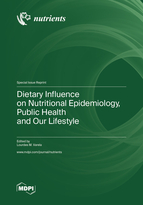Dietary Influence on Nutritional Epidemiology, Public Health and Our Lifestyle
A special issue of Nutrients (ISSN 2072-6643). This special issue belongs to the section "Nutrition and Public Health".
Deadline for manuscript submissions: closed (31 July 2021) | Viewed by 36525
Special Issue Editor
2. Departamento Fisiología Médica y Biofísica, Facultad de Medicina, Universidad de Sevilla, Sevilla, Spain
Interests: high-density lipoproteins (HDL); atherosclerosis; stroke; inflammation; leukocytes; olive oil; mediterranean diet; obesity
Special Issue Information
Dear Colleagues,
Nutritional Epidemiology and Public Health is a growing area of research that aims to investigate relationships between diet and disease, to develop and implement nutritional policies relevant to diet-health relations, in order to promote healthier lifestyles to prevent diseases and to improve life expectancies for those already diagnosed. Recent advances and the integration of “omics” technologies into traditional nutritional epidemiology are making it possible to identify new dietary biomarkers that serve as a guide for scientists to understand the biological mechanism by which diet can influence health.
This Special Issue of Nutrients, entitled “Dietary Influence on Nutritional Epidemiology, Public Health and Our Lifestyle”, welcomes the submission of significant contributions that increase knowledge of how diet/dietary components may influence health at molecular and human population levels, in particular original research that examines the diet-modulated biological pathways applying novel methodologies, including metabolomics techniques and bioinformatic tools. Potential topics may include but are not limited to the associations between dietary patterns and lifestyle in the risk and management of non-communicable diseases such as obesity, atherosclerosis, and diabetes type II.
Dr. Lourdes Varela
Guest Editor
Manuscript Submission Information
Manuscripts should be submitted online at www.mdpi.com by registering and logging in to this website. Once you are registered, click here to go to the submission form. Manuscripts can be submitted until the deadline. All submissions that pass pre-check are peer-reviewed. Accepted papers will be published continuously in the journal (as soon as accepted) and will be listed together on the special issue website. Research articles, review articles as well as short communications are invited. For planned papers, a title and short abstract (about 100 words) can be sent to the Editorial Office for announcement on this website.
Submitted manuscripts should not have been published previously, nor be under consideration for publication elsewhere (except conference proceedings papers). All manuscripts are thoroughly refereed through a single-blind peer-review process. A guide for authors and other relevant information for submission of manuscripts is available on the Instructions for Authors page. Nutrients is an international peer-reviewed open access semimonthly journal published by MDPI.
Please visit the Instructions for Authors page before submitting a manuscript. The Article Processing Charge (APC) for publication in this open access journal is 2900 CHF (Swiss Francs). Submitted papers should be well formatted and use good English. Authors may use MDPI's English editing service prior to publication or during author revisions.
Keywords
- Nutritional Epidemiology
- Public Health
- Lifestyle
- Dietary Patterns, Atherosclerosis
- Obesity
- Biomarkers







